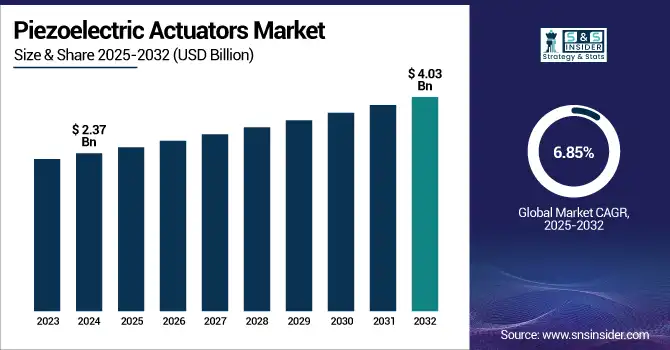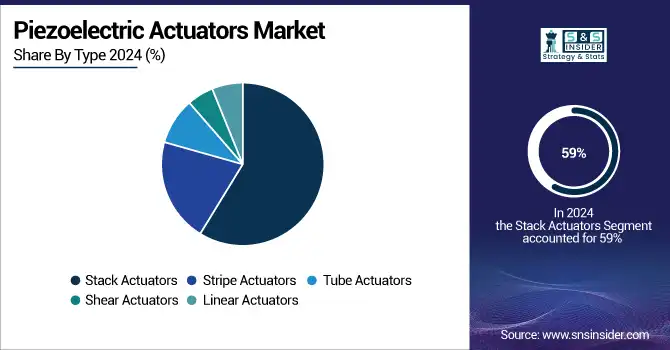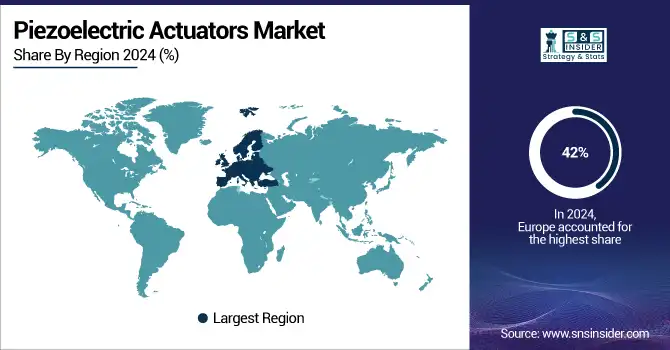Piezoelectric Actuators Market Size Analysis:
The Piezoelectric Actuators Market size was valued at USD 2.37 Billion in 2024 and is projected to reach USD 4.03 Billion by 2032, growing at a CAGR of 6.85% during 2025-2032.

To Get more information on Piezoelectric Actuators Market - Request Free Sample Report
The piezoelectric actuators market is growing due to the increasing demand for precision control with high-energy efficiency in industries such as medical devices, automotive, consumer electronics, and industrial automation. Numerous advantages of these actuators can be listed (e.g., fast response, compactness, accuracy for displacement) which primarily recommend their use for micrometer precision applications. Rising penetration in robotics, optical devices & inkjet printing is also encouraging the product adoption. Piezoelectric materials and actuator design have experienced several significant advancements towards improved performance and reliability. Nonetheless, costly fabrication and restricted freedom of movement are still primary issues. Continued research and technology advancement are anticipated to carve out new prospects in nascent smart technology.
Piezoelectric systems, typically used as actuators and sensors to convert mechanical stress into electrical energy, were evaluated for street lighting but proved highly inefficient—generating only 9.24 kWh/year despite 4,466 plates and 20,000 passing cars daily. Their inherent limitations in energy yield and high installation costs underscore why, despite their usefulness in precision engineering, they are unsuitable for large-scale power applications like street lighting.
The US piezoelectric actuators market was valued at 0.42 Billion in 2024 and is projected to reach USD 0.69 Billion by 2032, growing at a CAGR 6.60% during 2025-2032. The piezoelectric actuators market growth is fueled by the increasing demand for high-precision motion control across the automation and automotive industries. Due to their small size, fast response, and low energy consumption, they are desired for emerging applications with precise actuation demands.
Piezoelectric Actuators Market Dynamics:
Drivers:
-
Rising Demand for Precision and Reliability Drives Global Growth in Piezoelectric Actuators Market
The piezoelectric actuators market is experiencing robust growth due to increasing demand for extremely accurate and reliable actuation solutions in various fields such as medical, semiconductor, optics and industrial automation. These applications need actuators, which are able to work reliably under harsh conditions (e.g., high temperature and in humid environment), and meet the requirement of sub nanometer precision and fast response time. Furthermore, the growing utilization of automation and innovations in precision engineering coupled with significant investments in advanced medical and semiconductor equipment is driving market growth. Higher-performing and more durable actuators, in addition to much-reduced lead times, are increasing confidence for customers. These all contributes X-ray Piezoelectric actuators market to excel globally.
PI Ceramic has significantly reduced lead times for its durable, high-precision PICMA® Stack multilayer piezo actuators, enhancing their availability for demanding industrial and medical applications. This advancement supports ultra-high-vacuum environments and subnanometer precision, strengthening PI Ceramic’s position in cutting-edge piezo technology.
Restraints:
Complex Integration Issues Drive up Costs and Slow Adoption of Piezoelectric Actuators
Integrating piezoelectric actuators into existing systems presents significant challenges that can restrain market growth. These actuators often require specialized expertise due to their unique operating principles and sensitivity, which complicates seamless incorporation into diverse applications. Additionally, adapting current system designs to accommodate piezoelectric technology demands extensive engineering efforts, increasing both development time and overall project costs. The need for precise calibration and compatibility with other components further intensifies these complexities. For manufacturers and end-users, these integration hurdles can delay product launches and escalate expenses, potentially limiting widespread adoption. Addressing these technical and cost-related barriers is essential to fully capitalize on the market potential of piezoelectric actuators across various high-precision industries.
Opportunities:
-
Advanced Integration Drives Growth in Piezoelectric Actuator Vibration Control Systems
The use of dual-core processors and a human interface makes a significant contribution to piezoelectric actuator based vibration control systems to make them more sensitive, more accurate and easier to use. Such mechanisms enable adjustment while worn, in response to changes in vibrations, and are the reason why they are indispensable in such fields as the manufacture of semiconductors and precision instruments, which require drastic environmental control. The increasing demand for these actuators in turn leads to development of the technologies of endurance, sensitivity, and control. The advancements serve to reduce down time of the equipment, increase production efficiency and maintain with strict operating parameters leading to greater acceptance. In addition, more efficient energy usage and reduced investment in infrastructure lead to sustainable production. The integration of state-of-the-art hardware and easy-to-use software drives growing global market opportunities, and places piezoelectric actuator technology an essential element for delivering accuracy and dependability in advanced industrial applications, where greater automation and quality are required.
TMC’s STACIS® III uses advanced piezoelectric actuators and dual-core processing to deliver superior real-time vibration cancellation, enhancing equipment performance and enabling use in high-vibration environments.
Challenges:
-
Limited Displacement Range Restricts Broader Application of Piezoelectric Actuators
Piezoelectric actuators are renowned for their precision and rapid response, but their limited displacement range will be a serious obstacle for further wide applications. In general, these actuators offer very limited displacement stroke, typically at the low micrometric scale, which limits their applicability to those applications that require larger displacements or mechanical travels. In order to overcome this drawback, extra mechanical boosting mechanisms have to be employed, or hybrid systems have to be developed, which results in more complexity, size, and budget. As result, piezoelectric actuators as standalone solution may not be accepted in industries requiring high degree of precision and large stroke. Overcoming this limitation via novel materials or actuator design is fundamental to extend their use and open new markets in applications such as robotics, aerospace, and industrial automation.
Piezoelectric Actuators Market Segmentation Analysis:
By Type
The stack actuators segment held a dominant piezoelectric actuators market share of around 59% in 2024, their demand can be credited to high force output and precision whereas being beneficial for use in the medical devices, semiconductor production, and business automation subsequently contributing to boosting the market all across the globe.
The stripe actuators segment is expected to experience the fastest growth in the piezoelectric actuators market over 2025-2032 with CAGR 10.73%, This growth is attributed to the increasing need for flexible, lightweight, and high-precision actuators required in areas such as wearables, robotics, and micro-electromechanical systems (MEMS), which has been driving innovation and market growth, globally.

By Application
The industrial manufacturing segment held a dominant piezoelectric actuators market share of around 45% in 2024, and is expected to remain the largest and fastest growing segment owing to the increasing adoption of automation, requirement for high definition motion control, and durable actuators in harsh industrial environments. Use in robotics, quality control and process management are helping to drive demand for this market.
The automotive segment is expected to experience the fastest growth in the piezoelectric actuators market over 2025-2032 with CAGR 9.47%, which is primarily due to growing deployment of advanced driver assistance systems (ADAS) and electric vehicles in the developing and developed countries and for the better control of automotive components, to increase the reliability and efficiency of piezoelectric actuators are required.
By Material
The piezoelectric ceramic segment held a dominant piezoelectric actuators market share of around 68% in 2024, owing to excellent piezoelectric properties, durability, and cost-effectiveness of this material, thereby making it well-suited for medical devices, industrial automation, and consumer electronics. Increase in demand for high performance actuators also drives the growth of this segment.
The piezoelectric polymer is expected to experience the fastest growth in the piezoelectric actuators market over 2025-2032 with CAGR 11.17%, owing to their flexible and lightweight nature, and are better suited for wearable electronics and flexible devices in order to cater to growing demand for closed, low-profile, and innovative actuation solutions in emerging markets.
Piezoelectric Actuators Market Regional Analysis:
In 2024, the Europe dominated the piezoelectric actuators market and accounted for 42% of revenue share, strong focus on innovation, heavy investments in R&D for innovation and development, and high demand for the same from the automotive, healthcare, and semiconductor industries will drives the market growth and makes Europe a crucial piezoelectric actuator development and application genre.
Germany, France, and the UK drive Europe's piezoelectric actuator with the high R&D investment, development of new products, well-established manufacturing facilities, and increasing demand across various end user industries. These countries are the epicentres of innovation and technology implementation in the industry.
Asia-Pacific is projected to register the fastest CAGR of 9.84% during 2025-2032, rising industrialization, increasing electronics production, and increasing automotive & healthcare sectors. Nations such as China, Japan, and South Korea are making huge investment in smart technologies, raising requirement for precision components such as piezoelectric actuators in varied applications.
In Asia Pacific, China leads the piezoelectric actuators market, Owing to the massive electronics manufacturing and increasing implementation of smart automation, along with support from the government for the advanced industrial technologies.
In 2024, Europe emerged as a promising region in the piezoelectric actuators market, with strong innovation ecosystem and increasing R&D investment and demand for automotive, health care, and semiconductor applications. These conditions collectively make Europe a well-situated hub for developing and using advanced piezoelectric actuators.
The U.S. holds the largest share in the piezoelectric actuators market, owing to robust technological innovations, heavy R&D investment, and demand from aerospace, automobile and medical device production sectors.
LATAM and MEA is experiencing steady growth in the piezoelectric actuators market, owing to the growth in the industrial automation, growing penetration of energy-efficient technologies as well as increasing investment in the medical and automotive sector. An increase in manufacturing capabilities and infrastructure growth also facilitate adoption in these emerging regions.

Get Customized Report as per Your Business Requirement - Enquiry Now
Key Players:
The piezoelectric actuators market companies are Physik Instrumente (PI), TDK Corporation, Murata Manufacturing, CTS Corporation, CeramTec GmbH, APC International, KEMET Corporation (TOKIN), Piezosystem Jena, Thorlabs Inc., and Cedrat Technologies are the key active players in the piezoelectric actuators market.
Recent Developments:
-
In Oct 2024, TDK is driving the AI revolution with innovations like the spin memristor, drastically cutting AI power consumption to 1/100th of traditional devices. Their TDK SensEI group combines sensor fusion, AI, and electronics to boost productivity in Industry 4.0, renewable energy, and manufacturing.
-
In October 2024, Murata Manufacturing Co., Ltd. showcased its latest wellness-focused innovations at CEATEC 2024 under the theme "Society 5.0", including a clip-on wearable for women’s health that monitors internal abdominal temperature during sleep to help track menstrual cycles—offering a convenient, non-invasive alternative to oral thermometry, and contributing to personalized health management through IoT integration.
| Report Attributes | Details |
|---|---|
| Market Size in 2024 | USD 2.37 Billion |
| Market Size by 2032 | USD 4.03 Billion |
| CAGR | CAGR of 6.85% From 2025 to 2032 |
| Base Year | 2024 |
| Forecast Period | 2025-2032 |
| Historical Data | 2021-2023 |
| Report Scope & Coverage | Market Size, Segments Analysis, Competitive Landscape, Regional Analysis, DROC & SWOT Analysis, Forecast Outlook |
| Key Segments | • By Type(Stack Actuators, Stripe Actuators, Tube Actuators, Shear Actuators and Linear Actuators) • By Application(Aerospace, Automotive, Industrial Manufacturing, Healthcare, Consumer Electronics and Others) • By Material(Piezoelectric Ceramic, Piezoelectric Crystal, Piezoelectric Composite and Piezoelectric Polymer) |
| Regional Analysis/Coverage | North America (US, Canada, Mexico), Europe (Germany, France, UK, Italy, Spain, Poland, Turkey, Rest of Europe), Asia Pacific (China, India, Japan, South Korea, Singapore, Australia, Taiwan, Rest of Asia Pacific), Middle East & Africa (UAE, Saudi Arabia, Qatar, South Africa, Rest of Middle East & Africa), Latin America (Brazil, Argentina, Rest of Latin America) |
| Company Profiles |
The piezoelectric actuators market companies are Physik Instrumente (PI), TDK Corporation, Murata Manufacturing, CTS Corporation, CeramTec GmbH, APC International, KEMET Corporation (TOKIN), Piezosystem Jena, Thorlabs Inc., and Cedrat Technologies are the key active players in the piezoelectric actuators market. |

